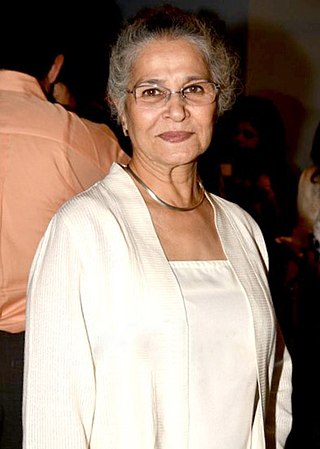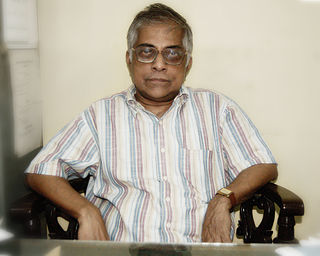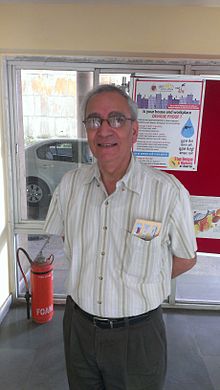
Tata Institute of Fundamental Research (TIFR) is a leading research Institute under the Department of Atomic Energy of the Government of India. It is a public deemed university located at Navy Nagar, Colaba in Mumbai. It also has a centres in Bangalore, Pune and Hyderabad. TIFR conducts research primarily in the natural sciences, the biological sciences and theoretical computer science.

Mambillikalathil Govind Kumar Menon also known as M. G. K. Menon, was a physicist and policy maker from India. He had a prominent role in the development of science and technology in India over four decades. One of his most important contributions was nurturing the Tata Institute of Fundamental Research, Mumbai, which his mentor Homi J. Bhabha founded in 1945.
George Ernest Kalmus, CBE, FRS is a noted British particle physicist.

Vijaya Mulay was a documentary filmmaker, film historian, writer, educationist and researcher.

Suhasini Mulay is an Indian actress in Assamese, Bollywood and Marathi films as well as television. She won five National Film Awards.

India-based Neutrino Observatory (INO) is a particle physics research project under construction to primarily study atmospheric neutrinos in a 1,200 meters (3,900 ft) deep cave under INO Peak near Theni, Tamil Nadu, India. It is planned to provide a precise measurement of neutrino mixing parameters. The project is a multi-institute collaboration and one of the largest experimental particle physics projects undertaken in India.
Spenta R. Wadia is an Indian theoretical physicist with research interests in elementary particle physics, quantum field theory and statistical physics, string theory and quantum gravity. His other scientific interests are in complex systems including cross-disciplinary biology. He is a recipient of the 2004 TWAS Prize in Physics; the 1995 Physics Prize of the International Centre for Theoretical Physics (ICTP); and the J. C. Bose Fellowship of the Govt of India. He is an elected member of TWAS, and a Fellow of all the Science Academies of India. In 2024, he was elected to the American Academy of Arts and Sciences, one of the United States' oldest and most prestigious scholarly societies.

Amitava Raychaudhuri is an Indian theoretical particle physicist. He is Professor Emeritus at the Physics Department of the Science College, University of Calcutta where he earlier held the Sir Tarak Nath Palit Chair Professorship. He is the nephew of another renowned Indian physicist, Amal Kumar Raychaudhuri.
Amol Dighe is a Professor of Physics in Tata Institute of Fundamental Research, Mumbai, India. He studied in Saraswati Secondary School, Thane, Maharashtra up to 10th grade and attended D. G. Ruparel College for the next 2 years. He was awarded the Shanti Swarup Bhatnagar Prize for science and technology, the highest science award in India, for the year 2013 in physical science category. His main research interest is in the area of high energy physics with focus on particles known as neutrinos, their nature and the role they play in astrophysics and cosmology. Dighe completed his BTech in Engineering Physics (1992) from Indian Institute of Technology, Bombay, MS and PhD (1997) from University of Chicago. Later he did postdoctoral research at ICTP, Trieste, CERN and Max Planck Institute before joining TIFR as a faculty member in 2003. He is a fellow the Indian Academy of Sciences and has won the Swarnajayanti Fellowship from the Department of Science and Technology, Government of India.

Professor Ramakrishna Vijayacharya Hosur is an Indian biophysical scientist, known for his expertise in the areas of nuclear magnetic resonance and molecular biophysics. The Government of India honoured him, in 2014, by awarding him the Padma Shri, the fourth highest civilian award, for his contributions to the fields of science and technology.
Ramanath Cowsik is an Indian astrophysicist and the James S. McDonnell Professor of Space Sciences at Washington University in St. Louis. He is considered by many as the father of astroparticle physics. A recipient of the Shanti Swarup Bhatnagar Prize, Cowsik was honored by the Government of India, in 2002, with the fourth highest Indian civilian award of Padma Shri
Badanaval Venkatasubba Sreekantan was an Indian high-energy astrophysicist and a former associate of Homi J. Bhabha at the Tata Institute of Fundamental Research (TIFR). He was also a Dr. S. Radhakrishnan Visiting Professor at the National Institute of Advanced Studies, Bangalore.
Amitava Datta is an Indian scientist working in the area of high energy physics, especially in context of new physics through direct and indirect.
Virendra Singh is an Indian theoretical physicist and a former C. V. Raman chair professor and director of the Tata Institute of Fundamental Research (TIFR). Known for his research in high energy physics, Singh is an elected fellow of all the three major Indian science academies - Indian National Science Academy, Indian Academy of Sciences and National Academy of Sciences, India as well as The World Academy of Sciences. The Council of Scientific and Industrial Research, the apex agency of the Government of India for scientific research, awarded him the Shanti Swarup Bhatnagar Prize for Science and Technology, one of the highest Indian science awards, for his contributions to Physical Sciences in 1973.
Sudhanshu Shekhar Jha is an Indian condensed matter physicist and a former director of Tata Institute of Fundamental Research. Known for his research in optoelectronics, Jha is an elected fellow of all the three major Indian science academies – Indian National Science Academy, National Academy of Sciences, India and Indian Academy of Sciences – as well as of The World Academy of Sciences and American Physical Society. The Council of Scientific and Industrial Research, the apex agency of the Government of India for scientific research, awarded Jha the Shanti Swarup Bhatnagar Prize for Science and Technology, one of the highest Indian science awards, for his contributions to Physical Sciences in 1979.
Shasanka Mohan Roy is an Indian quantum physicist and a Raja Ramanna fellow of the Department of Atomic Energy at the School of Physical Sciences of Jawaharlal Nehru University. He is also a former chair of the Theoretical Physics Group Committee at Tata Institute of Fundamental Research. Known for developing Exact Integral Equation on pion-pion dynamics, also called Roy's equations, and his work on Bell inequalities, Roy is an elected fellow of all the three major Indian science academies – Indian Academy of Sciences, Indian National Science Academy, and National Academy of Sciences, India – as well as The World Academy of Sciences. The Council of Scientific and Industrial Research, the apex agency of the Government of India for scientific research, awarded Roy the Shanti Swarup Bhatnagar Prize for Science and Technology, one of the highest Indian science awards, for his contributions to Physical Sciences in 1981.
Probir Roy is an Indian particle physicist and a former professor at Tata Institute of Fundamental Research. He is also a senior scientist of the Indian National Science Academy at Bose Institute and a former Raja Ramanna fellow of Department of Atomic Energy at Saha Institute of Nuclear Physics.
Deepak Mathur is an Indian molecular and atomic physicist and was a Distinguished Professor at the Tata Institute of Fundamental Research. He has been the J C Bose National Fellow at the Department of Atomic and Molecular Physics at Manipal Academy of Higher Education (MAHE) and founding director of the UM-DAE Centre for Excellence in Basic Science at the University of Mumbai. Known for his research on molecular and biological physics, Mathur is an elected fellow of the Indian Academy of Sciences, Indian National Science Academy and The World Academy of Sciences. The Council of Scientific and Industrial Research, the apex agency of the Government of India for scientific research, awarded him the Shanti Swarup Bhatnagar Prize for Science and Technology, one of the highest Indian science awards, for his contributions to physical sciences in 1991. Amongst other awards, he has been the Royal Society's Guest Fellow at Oxford University and winner of the European Union's Erasmus-Mundus prize in optical science which he held at Imperial College London. Currently he is an adjunct professor at MAHE and is also learning to fly. His initial training was on a Grob G-115 2-seater training aircraft but he has now moved on to flying PA-28 4-seater aircraft.
Echur Varadadesikan Sampathkumaran is an Indian condensed matter physicist and a Distinguished Professor at the Tata Institute of Fundamental Research. Known for his research on the thermal and transport behaviour of magnetic systems, Sampathkumaran is an elected fellow of all the three major Indian science academies viz. Indian Academy of Sciences, Indian National Science Academy and National Academy of Sciences, India as well as The World Academy of Sciences. The Council of Scientific and Industrial Research, the apex agency of the Government of India for scientific research, awarded him the Shanti Swarup Bhatnagar Prize for Science and Technology, one of the highest Indian science awards, for his contributions to physical sciences in 1999.
Subir Sarkar is an Indian astroparticle physicist and cosmologist, known for his research demonstrating constraints on the dark sector.







